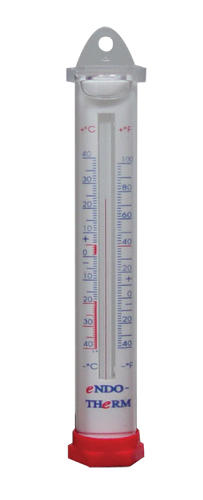 To be honest, there has been a lot of skepticism among the people I have talked to in the restaurant supply business when they first encounter the EndoTherm Thermometer. Maybe it’s the appearance: the oversized outer plastic shell, which houses a normal alcohol thermometer immersed in a special silicone gel, gives the impression of a child-safe toy, meant to be too big for choking. Maybe it’s the purpose: the EndoTherm accurately reads food temperature rather than air temperature, which sounds a little hokey to the old hands in the industry.
To be honest, there has been a lot of skepticism among the people I have talked to in the restaurant supply business when they first encounter the EndoTherm Thermometer. Maybe it’s the appearance: the oversized outer plastic shell, which houses a normal alcohol thermometer immersed in a special silicone gel, gives the impression of a child-safe toy, meant to be too big for choking. Maybe it’s the purpose: the EndoTherm accurately reads food temperature rather than air temperature, which sounds a little hokey to the old hands in the industry.
So what is the EndoTherm all about, anyway? Well, the official party line is that the gel around that regular alcohol thermometer mimics food product: when food freezes, the gel freezes, and the thermometer can therefore get an accurate reading of what’s going on inside your refrigerated product, as opposed to what the air around that product is doing.
Why is that good? There are two official reasons:
1) Air temperature varies in refrigeration units, especially ones that are opened and closed on a regular basis, like display cases or prep tables. A thermometer that only measure air temp is affected by how air is moving around the unit, and, especially if it’s at the back, away from the door, it could be reading colder than the food product sitting by the constantly opening door. This could affect food safety, since it’s possible to have food sitting in the danger zone even though the air temp thermometer is saying everything is fine.
If you were to place a couple EndoTherm thermometers around your refrigeration unit, one right by the door and some others in the middle and at the back, you would know just how well food in different spots were holding temperature.
2) You might also have the opposite problem: you are running the unit too cold. Again, airflow varies in any refrigeration unit and that can affect the air temp thermometer. Warmer air coming in from the opened and closed door might be bumping your thermometer up a degree or two, causing you to turn the thermostat down to keep everything below 40 degrees. And it’s possible that your food product is sitting at a very comfortable 35 degrees or so, unaffected by those little blasts of warm air.
Again, the placement of a few EndoTherms around the refrigeration unit might reveal that you can turn the thermostat up and still maintain food safety. And every degree you turn up translates into an 8% savings on the energy usage for that unit. Any restaurateur who has seen the electricity bill knows just how much money that means.
So maybe the EndoTherm isn’t so hokey after all. This thermometer was dreamed up by two fairly famous inventors in England and apparently it has been all the rage over there, and is just now catching on in North America. The reputation of the creators lends some credibility to the claim “accurately mimics food temperature.”
I think the jury is still out. Skepticism dies hard. I would love to hear from some people who have used the EndoTherm and have found it to be everything they ever dreamed of, and people who thought it really would be better as a kid’s toy. If you have some real world experience with this thermometer, leave a comment below and tell us about it!
 Corner Booth Blog | TundraFMP Restaurant Supply, News & Equipment Blog
Corner Booth Blog | TundraFMP Restaurant Supply, News & Equipment Blog




Thanks for writing about our product